Advait Jukar & Laura Bradley
Reed College
Migration of Humpback Whales (Megaptera Novaeangliae)
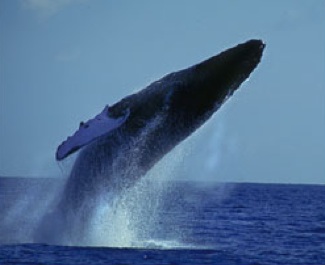
Background
A famous hobbit once wrote, "--not all those who wander are lost--” (Tolkein). Humpbacks are some of the greatest wanderers of the ocean, making annual migrations of over 16,000 miles from their high latitude summer feeding grounds to low latitude winter breeding grounds. Humpbacks range throughout all of the world’s major oceans. Three distinct populations have been observed, in the North Atlantic, North Pacific and Southern Ocean. These populations do not interbreed and the migration routes are specific to each group's feeding grounds. Female humpbacks are believed to migrate to lower latitudes during the winter to give birth in a warm, calm environment. Though populations that exist in the Northern and Southern hemispheres migrate in different directions to the their winter breeding grounds, the destinations share a similar profile. The winter grounds are generally between 24 and 28 C and relatively shallow. The mechanism of this epic journey is still an enigma to scientists. A probable hypothesis is the use of magnetoreception, or a magnetic sense, to navigate through the ocean.
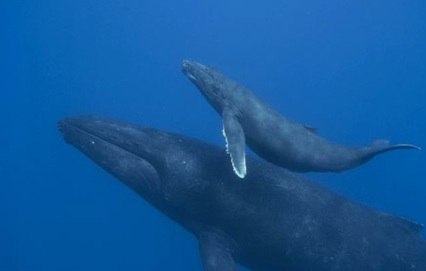
Calves that are born in the wintering grounds follow their mothers to the summer feeding grounds. This might be a way the calves learn the migration routes [see Ontogeny]. A common assumption is that all the whales migrate to lower latitudes during the winter (Craig & Herman 1997)[see Adaptive Value], but whaling records and recent studies have shown a skewed male-biased sex ratio of 2.4 to 1 at the breeding grounds. A possible explanation for this observation is that some females do not migrate every season to maintain their energy stores, because there is a lack of food at lower latitudes.
To date there is little phylogenetic evidence of migration. One proposed hypothesis of migration is magnetoreception, which would suggest that fossilized humpback whale bones have a high probability of occurring in sediments in low geomagnetic field gradients [see Phylogeny].
Distribution
Humpback whales are found in all oceans between the Arctic and Antactica (Johnson & Wolman 1984).
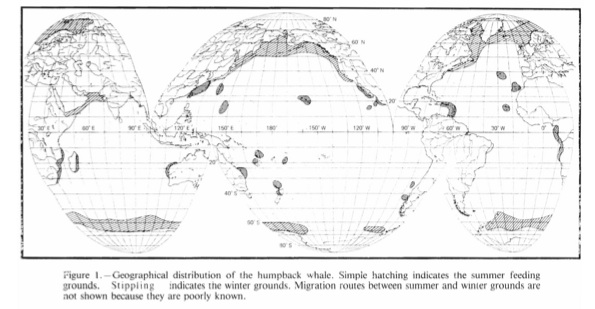
Three major populations include the North Atlantic population, North Pacific population and the Southern Ocean population (Figure 1).
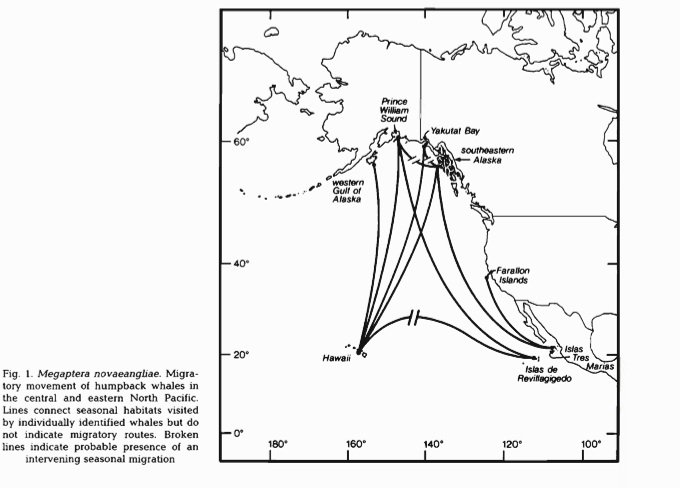
Pacific population: The summer feeding grounds of the North Pacific population range from the Berring Sea in the north to the Sanriku coast of Honshu on the Asian side, and approximately to Point Conception, California on the American side in the south (Johnson & Wolman 1984) (Figures 2,3). There are three major wintering grounds for the Pacific population:
1. Baja California in the south, to Isla San Jose in the Gulf of California in the north and from southern Sonora to Jalisco (Johnson & Wolman 1984).
2. Around the Hawaiian islands.
3. Around the Mariana Islands, the Bonin Islands, the Ryukyu Islands and Taiwan.
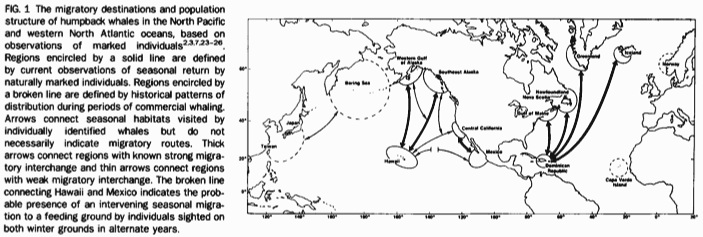
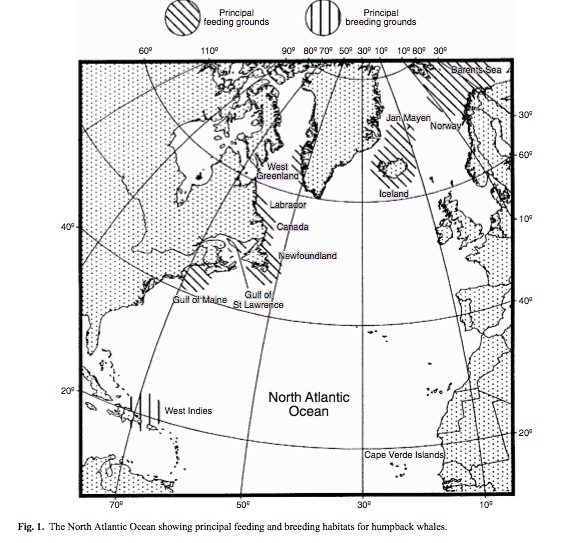
Atlantic population:The Eastern Atlantic stock has summer feeding grounds in the Barents sea, off Iceland, Scotland and Norway. This stock winters around the Cape Verde Islands off western Africa (Johnson & Wolman 1984). The western Atlantic stock has summer feeding grounds in New Foundland, the Gulf of Maine, southern Labrador, western Iceland and southwestern Greenland. This stock winters in the West Indies, the Dominican Republic and along the Puerto Rican coast (Johnson & Wolman 1984) (Figures 3,4)
Southern Ocean population:The Southern Ocean population has its feeding grounds in the Antarctic, South Shetland Islands, south of the West and East coasts of Africa, Australia and South America. The wintering grounds lie along the tropical western sides of each of the above continents (Johnson & Wolman 1984).
These difference populations all share a common paradigm: humpback whales must travel long distances to maximize their reproductive fitness in the wild. When the best feeding area is thousands of miles from the best breeding grounds, these creatures have no choice but to spend the majority of their energy on performing this epic journey.